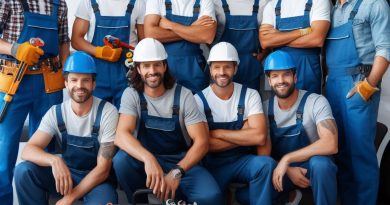Safety Protocols and Standards for US Plumbers
Last Updated on January 27, 2024
Introduction
Safety protocols and standards are crucial for plumbers to protect themselves and the public.
This blog post aims to discuss the importance of safety protocols and standards for plumbers.
Safety is a key concern in any profession, and it is no different for plumbers.
Plumbers work with complex systems that involve water, gas, and other potentially hazardous materials.
Therefore, they must adhere to strict safety protocols and standards to ensure their own well-being as well as the safety of their clients and the general public.
The purpose of this blog post is to highlight the significance of these safety protocols and standards in the plumbing industry.
By following these guidelines, plumbers can minimize the risk of accidents, injuries, and even fatalities.
Not only do these protocols protect the lives of plumbers, but they also guarantee the well-being of the clients who rely on their services.
Safety protocols and standards cover a wide range of areas, including the proper use of personal protective equipment (PPE), adherence to building codes, and maintaining a safe work environment.
Plumbers must also stay up-to-date with the latest industry standards and regulations to ensure their work meets the highest safety standards.
This blog post will delve into specific safety protocols and standards that plumbers should follow, providing practical tips and guidance to help them navigate potential risks.
By prioritizing safety, plumbers can not only maintain a professional reputation but also contribute to the overall well-being of the plumbing industry.
In the following sections, we will discuss various safety measures, such as hazard identification, safety training, and the importance of regular equipment maintenance.
Together, let’s ensure a safer working environment for plumbers and a more secure plumbing system for everyone.
Overview of Safety Protocols and Standards
Definition of safety protocols and standards
In the plumbing profession, safety protocols refer to a set of established guidelines and procedures that ensure the well-being of plumbers, clients, and the general public during plumbing activities.
On the other hand, safety standards are a set of rules and regulations that dictate the minimum requirements for safe and compliant plumbing practices.
Explanation of their significance in the plumbing profession
Safety protocols and standards play a crucial role in the plumbing profession.
They help prevent accidents, injuries, and fatalities in the workplace.
By following these protocols and standards, plumbers can create a safe working environment, mitigate potential hazards, and protect themselves and others from harm.
Compliance with safety protocols and standards also enhances the reputation and credibility of plumbers, as it reflects their professionalism and commitment to high-quality work.
Brief history of the development of safety protocols and standards for plumbers in the US
The development of safety protocols and standards for plumbers in the United States has evolved over time to address the changing needs of the industry.
During the early years of plumbing, safety measures were often neglected, leading to numerous accidents and health risks for plumbers.
However, as the industry grew and awareness of workplace safety increased, organizations like the Occupational Safety and Health Administration (OSHA) were established to set safety standards and enforce compliance.
In 1971, OSHA was created to ensure safe and healthy working conditions for workers across various industries, including plumbing.
Since then, OSHA has developed specific standards for plumbing-related activities, such as the proper handling of hazardous materials, the use of personal protective equipment, and the prevention of falls and injuries.
These safety protocols and standards have significantly contributed to the reduction of workplace accidents and injuries in the plumbing profession.
Over the years, advancements in technology and best practices have further refined safety protocols and standards, incorporating new techniques and equipment to enhance worker safety.
Plumbing organizations and associations also play a vital role in promoting safety in the profession.
They offer training programs, certifications, and resources to educate plumbers about the latest safety protocols and standards.
By staying updated with these developments, plumbers can adapt and implement effective safety measures, ensuring the well-being of themselves and those they serve.
In short, safety protocols and standards are fundamental in the plumbing profession. They define the guidelines plumbers must follow to maintain a safe working environment, protect against hazards, and prevent accidents.
The evolution of these protocols and standards signifies the industry’s commitment to prioritizing the well-being of plumbers and ensuring the delivery of quality plumbing services.
Read: Post-pandemic Welding: Changes and Trends in the US Market
OSHA’s Role in Ensuring Safety in Plumbing
Introduction to Occupational Safety and Health Administration (OSHA)
The Occupational Safety and Health Administration, commonly known as OSHA, plays a vital role in ensuring the safety of plumbers and other workers in various industries.
Explanation of OSHA’s role in establishing safety regulations for plumbers
OSHA is responsible for developing and enforcing regulations related to workplace safety and health.
For plumbers, OSHA sets specific standards to protect them from hazards.
OSHA’s main objective is to prevent work-related injuries, illnesses, and fatalities by promoting safe working conditions.
To achieve this, OSHA regularly inspects workplaces, investigates accidents, and educates employers and workers about safety measures.
When it comes to plumbers, OSHA has established regulations to address the unique risks associated with their profession.
Overview of OSHA’s standards specific to the plumbing industry
- Hazardous Chemicals: Plumbers often work with hazardous chemicals such as solvents and adhesives.
OSHA’s Hazard Communication Standard ensures employers provide proper labeling and safety data sheets for these substances. - Confined Spaces: Plumbers frequently encounter confined spaces like pipes, tanks, and manholes.
OSHA’s Confined Space Entry Standard establishes procedures to protect workers from potential hazards in these enclosed areas. - Fall Protection: Working at heights is common in the plumbing industry. OSHA’s Fall Protection Standard requires employers to provide fall protection equipment to prevent falls from elevated platforms or ladders.
- Respiratory Protection: Plumbers may be exposed to harmful fumes or airborne contaminants.
OSHA’s Respiratory Protection Standard mandates employers to provide suitable respiratory equipment and establish respiratory protection programs. - Excavations: Plumbers often dig trenches and excavations for installing or repairing pipes.
OSHA’s Excavation Standard sets requirements for protective systems and cave-in prevention to ensure worker safety. - Personal Protective Equipment (PPE): OSHA’s PPE Standard mandates the use of appropriate protective equipment, such as gloves, eye protection, and hard hats, to reduce the risk of injuries in the plumbing industry.
- Electrical Safety: Plumbers may encounter electrical hazards while working on water heaters, pumps, or circuits.
OSHA’s Electrical Safety Standards address potential electrical dangers and provide guidelines for safe practices. - Plumbing Tools and Equipment: OSHA’s General Industry standards cover the safe use and maintenance of tools, equipment, and machinery commonly used by plumbers.
By implementing these standards, OSHA aims to protect plumbers from injuries, illnesses, and fatalities associated with their work.
However, it’s crucial for plumbers and employers in the plumbing industry to understand and comply with OSHA’s regulations to ensure a safe working environment.
In essence, OSHA plays a crucial role in safeguarding the well-being of plumbers by establishing and enforcing safety regulations specific to the plumbing industry.
These regulations cover various aspects such as hazardous chemicals, confined spaces, fall protection, respiratory protection, excavations, personal protective equipment, electrical safety, and plumbing tools and equipment.
By adhering to OSHA’s standards, plumbers can mitigate the risks associated with their profession and work in a safer environment.
Read: Veterans Transitioning into Welding Careers in the United States

Key Safety Protocols and Standards for Plumbers
Personal Protective Equipment (PPE)
- Plumbers should wear essential PPE items such as safety goggles, gloves, and hard hats.
- Wearing appropriate PPE reduces the risk of injuries and exposure to hazardous substances.
Hazardous Material Handling
- Plumbers must follow specific guidelines when handling and disposing of hazardous materials.
- Proper training for handling hazardous substances is crucial in ensuring safety and minimizing risks.
Fall Protection
- Plumbers working at heights should implement fall protection measures to prevent accidents.
- Various fall protection systems and devices, like safety harnesses and guardrails, should be utilized.
Confined Space Entry
- Working in confined spaces poses several hazards, including exposure to toxic gases and lack of ventilation.
- Plumbers must follow strict safety protocols when entering and working in confined spaces.
Safety plays a paramount role in the plumbing industry, and it is imperative for plumbers to adhere to specific protocols and standards to ensure their well-being.
This section will explore key safety protocols and standards that plumbers should follow to minimize risks and prevent accidents.
Personal Protective Equipment (PPE)
Personal Protective Equipment (PPE) is essential for plumbers to safeguard themselves from potential hazards while performing their tasks.
Plumbers should wear the following essential PPE items:
- Safety goggles: These protect the eyes from debris, chemicals, and metal fragments.
- Gloves: High-quality gloves provide hand protection from sharp objects, chemicals, and other harmful substances.
- Hard hats: Wearing hard hats is crucial to protect plumbers from falling objects and head injuries.
Wearing appropriate PPE provides several benefits, including:
- Injury prevention: PPE reduces the risk of injuries, such as eye damage, hand injuries, and head trauma.
- Protection from hazardous substances: PPE acts as a barrier and minimizes the exposure to toxic chemicals and substances.
Hazardous Material Handling
Plumbers often come across hazardous materials during their work, including chemicals, asbestos, and other toxic substances.
It is crucial to handle and dispose of these materials safely. The following guidelines should be followed:
- Proper labeling and storage: Hazardous materials should be clearly labeled and stored in designated containers.
- Safe disposal procedures: Plumbers should be aware of proper disposal methods for different hazardous materials.
- Protective measures: Plumbers should use appropriate PPE when handling hazardous substances to minimize exposure.
Proper training for handling hazardous substances is of utmost importance.
Plumbers must be educated on the potential risks and the correct procedures to handle and manage such materials effectively.
Fall Protection
Plumbers often work at heights, which makes fall protection measures vital to prevent accidents and injuries. Some key fall protection measures include:
- Secure anchorage points: Plumbers should ensure that strong and secure anchorage points are available when working at heights.
- Safety harnesses: Plumbers should wear safety harnesses that are properly adjusted and secured to prevent falls.
- Guardrails and barriers: Installing guardrails and barriers around elevated work areas provide additional protection.
It is important for plumbers to be familiar with different fall protection systems and devices available to ensure the most suitable methods are employed.
Confined Space Entry
Working in confined spaces, such as utility vaults and crawl spaces, presents unique challenges and potential hazards.
Plumbers must be aware of the following when working in confined spaces:
- Hazards associated with confined spaces: Confined spaces can have limited ventilation, toxic gases, and the risk of entrapment.
- Safety protocols for entering confined spaces: Plumbers should follow specific procedures that involve proper ventilation, testing for hazardous gases, and using personal protective equipment.
By strictly adhering to safety protocols, plumbers can mitigate the risks associated with working in confined spaces and ensure their safety.
Essentially, personal protective equipment, proper handling of hazardous materials, fall protection, and confined space entry protocols are pivotal for the safety of plumbers.
Following these protocols not only minimizes risks but also creates a conducive work environment where accidents are prevented, and well-being is prioritized.
Read: Navigating the American Welding Society (AWS) Certification Path
Training and Education for Plumbers
Importance of proper training and education for plumbers
Proper training and education are essential for plumbers to ensure their competence and expertise.
Without proper training, plumbers may lack the necessary skills to handle complex plumbing tasks.
Well-trained plumbers also have a better understanding of safety protocols and can identify potential hazards.
Investing in training and education results in highly skilled plumbers who provide quality service.
Overview of certification and licensing requirements for plumbers in the US
Plumbers in the US must meet specific certification and licensing requirements to practice their profession.
State licensing boards typically determine these requirements, which vary from state to state.
Certifications such as the Journeyman Plumber and Master Plumber licenses indicate expertise and experience.
Licensing ensures that plumbers adhere to safety standards and are accountable for their work.
Availability of safety-focused training programs for plumbers
Specialized training programs are available to provide plumbers with safety-focused education.
These programs cover essential safety protocols, including proper handling of hazardous materials and personal protective equipment.
Safety-focused training helps plumbers minimize accidents and injuries on worksites.
Plumbers who undergo safety training are equipped to handle emergency situations effectively.
Read: Top Welding Equipment Brands and Tools Preferred in the US
Gain More Insights: US Welder Shortage: Myth or Reality in Today’s Market?
Current Challenges and Future Outlook
Discussion of current challenges in implementing safety protocols and standards
- Insufficient awareness among plumbers about safety protocols leads to negligence.
- Lack of strict enforcement of safety standards by regulatory bodies hampers progress.
- Resistance to change and reluctance to adopt new safety measures pose challenges.
- Inadequate training programs result in a lack of knowledge about updated safety protocols.
- Complexity of plumbing projects makes it difficult to ensure strict adherence to safety guidelines.
Introduction to ongoing efforts to improve safety in the plumbing industry
- Increased focus on safety training programs for plumbers to enhance awareness and skills.
- Collaboration between industry associations and regulatory bodies to enforce safety standards.
- Regular inspections and audits to identify non-compliance and improve safety protocols.
- Implementation of reward systems to incentivize adherence to safety protocols in the plumbing industry.
- Integration of safety protocols into plumbing curricula to ensure future plumbers are well-prepared.
Impact of technological advancements on safety protocols for plumbers
- The use of smart tools and equipment enhances safety by minimizing manual handling.
- Advanced leak detection systems help prevent accidents and potential water damage.
- Remote monitoring and control systems enable real-time safety management and troubleshooting.
- Virtual reality (VR) training programs provide immersive learning experiences for plumbers.
- Integration of Internet of Things (IoT) technology allows for proactive safety monitoring and alerts.
In the dynamic plumbing industry, addressing safety challenges is paramount for implementation of protocols and standards.
Plumbers must grasp the significance of safety measures and comprehend the potential consequences of negligence.
Regulatory bodies actively enforce safety standards, ensuring compliance and holding plumbers accountable for their actions.
Ongoing efforts focus on enhancing safety in plumbing, emphasizing extensive safety training programs for plumbers.
Collaboration between industry associations and regulatory bodies remains essential for consistent promotion and enforcement of safety standards.
Technological advancements significantly impact plumbers’ safety, with smart tools reducing manual handling and minimizing injury risks.
Advanced leak detection systems play a crucial role in identifying and preventing potential accidents and water damage.
Remote monitoring and control systems facilitate real-time safety management, enabling swift troubleshooting.
Virtual reality (VR) training programs provide immersive learning experiences, allowing plumbers to practice scenarios in a safe environment.
Integration of Internet of Things (IoT) technology ensures proactive safety monitoring and alerts for timely hazard mitigation.
Looking ahead, the plumbing industry must prioritize safety through continuous updates to protocols and standards.
A proactive approach, fostering a safety culture and raising awareness, will contribute to a safer working environment for all plumbers.
Conclusion
Safety protocols and standards are crucial for US plumbers to ensure their well-being and the safety of their clients.
By following safety protocols and standards, plumbers can reduce the risk of accidents, injuries, and property damage.
Plumbers must prioritize safety in their work to prevent accidents, injuries, and even fatalities. This means being aware of the potential hazards associated with plumbing work and taking steps to mitigate those hazards.
It also means following safety protocols and standards, such as wearing the proper personal protective equipment and using safe work practices.
It is essential for plumbers to stay updated with evolving standards and regulations to maintain a safe working environment.
Safety protocols and standards are constantly evolving to reflect new knowledge and technologies.
Plumbers must stay updated with evolving standards and regulations in order to ensure that they are providing the safest possible service to their clients.


